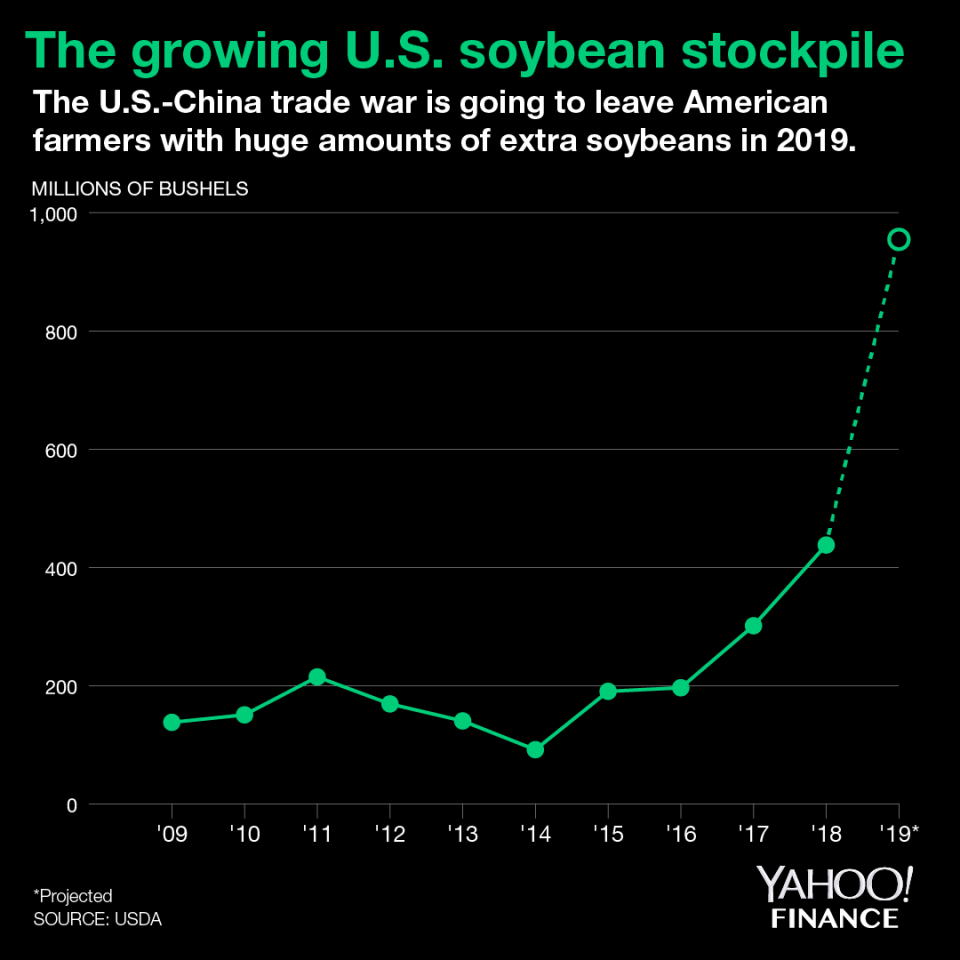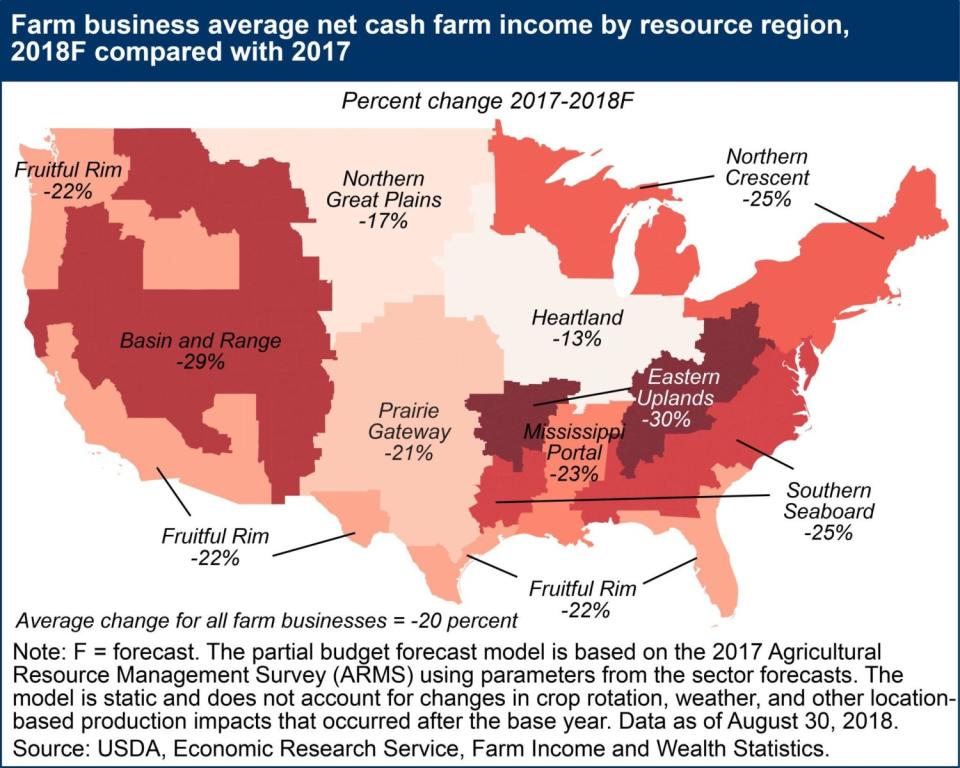The growing U.S. soybean stockpile could come back to haunt Trump
As the trade war with China continues, U.S. farmers feel acute effects from tit-for-tat tariffs.
And despite the Trump administration giving American farmers the revenue made from new tariffs on China, the growing stockpile of certain U.S. agricultural products could become a political problem for the president.

The growing U.S. soybean stockpile and ‘long-term damage’
From 2000 to 2017, Chinese imports of U.S. soybeans steadily increased. In 2016 and 2017, the U.S. exported 67,854,202 metric tons of soybeans to China, which was good for about 60% of total U.S. soybean exports during those two years.
In 2018, amid trade tensions, China basically stopped importing U.S. soybeans: Through September 2018, U.S. soybean exports China were down 98% compared to 2017. At the same time, the USDA forecasted that soybean production for 2018 will be an increase of 7% from 2017.
As a result, U.S. soybean inventory is poised to reach an estimated 955 million bushels in 2019, nearly doubling the 2018 stockpile.
“One of the problems we’ve all struggled with is trying to describe what’s happened to us,” Blake Hurst, a soybean farmer and president of the Missouri Farm Bureau, told Yahoo Finance recently. “We’ve seen record yields, a record crop this year, and a $2, or about a 10%, drop in soybean prices.
“Some of that due to the tariffs and the trade problems, but some of it due just to a big crop that we have to figure out how to market. So, the combination [of] the two has been pretty stressful for farmers.”

In December 2018, China pledged to begin buying U.S. soybeans in a good faith gesture. However, that will not offset existing losses. “We are disappointed with the sales to China,” Ted Seifried, chief market strategist at Zaner in Chicago, told Bloomberg. “We needed at least 10 million metric tons, we got 1.1 million.” And the American Soybean Association stated that the deal “will not fix the prolonged period of low prices soybean farmers have faced since the trade war began.”
Hurst agreed. “I do think some long-term damage has been done to our export markets,” Hurst told Yahoo Finance in a follow-up interview. “It will take a while to repair that, even without tariffs.”
The U.S. and China will continue negotiating into 2019, with a hard deadline for a comprehensive trade deal set for March 1.
‘Even harder for the agricultural sector’
The pain extends to all kinds of farmers hit by the trade war.
“The issue with the tariffs is this tit-for-tat relationship,” Todd Kuethe, clinical assistant professor at the University of Illinois’ Department of Agricultural and Consumer Economics, told Yahoo Finance. “If we impose additional tariffs, they’re likely to respond by increasing tariffs. The question is, will they increase tariffs on soybeans and pork, which have already been targeted, or focus on additional exports?”
One major challenge the U.S. faces, Kuethe said, is that it isn’t a major exporter of goods aside from agricultural commodities. As a result, according to Kuethe, “we’ll likely see a measured response from China that’s even harder for the agricultural sector.”

Kuethe noted that soybeans are particularly important for U.S. farmers because they can be grown in a lot of places.
“Look where they’re grown in the U.S. — from Kansas to Georgia to Tennessee to Minnesota and Michigan,” he said. “It’s got a wide production footprint, which makes it good for growing in combination with other things, like peanuts and corn.”

Solving the U.S. soybean stockpile problem is ‘pretty simple’
Any political implications from the American agricultural pain would come in 2020. So the end of a trade war could ease the effects considerably before the next votes are cast — or the issues could fester.
“By launching a trade war with China, therefore, the president has simultaneously raised taxes on U.S. companies and lost the government money,” the Council on Foreign Relations concluded after Trump approved more financial relief from farmers. “And with the farm constituency critical to his 2020 re-election hopes, the losses are only set to mount going forward.”
Kuethe sees trade disputes as more of an “executive branch issue” and generally, farmers “hate that the trade dispute exists and want it to end.” He noted that farmers are often older but technically small business owners.
“Both of those are big, consistent voter demographics on their own,” he explained. “One of the reasons why agriculture policy gets treated very respectfully from both political parties because of its huge demographic. The bigger fear I would have if I was running for office is to make sure that farmers feel engaged enough to come out and vote.”

Kuethe doesn’t see the tariffs playing a role in the 2020 elections — yet.
“If the tariffs thing drags on for two more years, we’ll see ramifications across the board for all races, not just presidential,” he said. “Two years is a lifetime and at that point, it becomes a big political issue. Right now, it’s a relatively short episode. But most farmers are hopeful we’ll pull out of it pretty soon.”
Hurst, the soybean farmer, agrees that 2020 is a long way away and noted that “farmers I’ve talked to are pretty supportive of Trump.”
However, for the president to retain that support, “he needs to get an agreement with China that’s written down on paper, that’s clear, that everyone understands, and that reduces the tariffs that China has put on our exports,” Hurst said. “It’s pretty simple.”
Adriana is an associate editor for Yahoo Finance. Follow her on Twitter @adrianambells.
READ MORE:
Wealth manager on trade tensions: ‘If you’re a soybean farmer in Iowa, it’s a war’
American farmer: ‘We would be much better off’ without Trump’s trade war
Brutal map shows why U.S. farmers want Trump to ‘end the trade war’
Follow Yahoo Finance on Twitter, Facebook, Instagram, YouTube, Flipboard, LinkedIn, and reddit.
